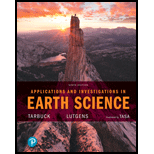
The distribution of earthquakes defines the boundaries of which major Earth feature?
The major Earth feature whose boundaries are defined by the distribution of earthquakes.
Introduction:
Earthquake is a sudden and violent shaking of the ground. It occurs by the movement of plates within the Earth’s crust. The sudden release of tension in the tectonic plates sends energy waves which travel through the Earth. An earthquake causes great destruction to property and human population.
Explanation of Solution
The major Earth feature whose boundaries are defined by the distribution of earthquakes is tectonic plates. The area where the tectonic plates are joined is considered an earthquake-prone area. The joint causes the seismic waves to move on the ground.
Want to see more full solutions like this?
Chapter 3 Solutions
Applications and Investigations in Earth Science (9th Edition)
Additional Science Textbook Solutions
College Physics: A Strategic Approach (3rd Edition)
Physics for Scientists and Engineers: A Strategic Approach, Vol. 1 (Chs 1-21) (4th Edition)
Microbiology with Diseases by Body System (5th Edition)
Microbiology: An Introduction
Laboratory Experiments in Microbiology (12th Edition) (What's New in Microbiology)
Brock Biology of Microorganisms (15th Edition)
- Discussion Question: River (or Stream) Systems A+ Should New Orleans have been reconstructed or not? 94 (b) 40 80 MILES Louisiana 40 80 KILOMETERS Old River Control Project Alexandria 93 Gulf of Mexico 92 Lake Pontobartrain Now Orleans Morgan City H High pressure PACIFIC OCEAN 30- General region of 150%+ precipitation during summer CP Cool, dry air Jer stream shed south Divergence mT air mass is pumped into the Midwest for weeks 400 800 MILES 400 800 KILOMETERS 120° Heal wave High pressure Stagnant air m Warm, wet unstable ATLANTIC OCEAN Tropic of Cancer 91 89 ° 110° 70°arrow_forwardLos Angeles's demand for water exceeds the amount of water available. There are no other new sources of water available, so Los Angeles is planning on constructing the high technology facilities necessary to produce drinking water from treated municipal wastewater (i.e. "Toilet to Tap"). Public perception (i.e. the "yuch! factor"), not well established, proven technology, to accomplish this task, is going to be the big problem. Develop a five (5) item marketing plan to convince the "beautiful" people of Los Angeles that drinking water that is recycled sewage that exceeds all U.S. EPA drinking water standards. This can be done because as Slide 63 shows, doctors once were used to sell Lucky Strike cigarettes - "Your throat protection: against irritation, against cough". Cigarettes, as is now known are harmful to your health while the drinking water produced from sewage is of equal quality and in many instances higher quality than your existing drinking water.arrow_forwardRead June 17, 2023, editorial from the Wall Street Journal entitled "Biden's Fishy Plan to Breach the Snake River Dams. The editorial raises a number of concerns about the plans of the administration of President Joseph Robinette Biden to remove four hydroelectric dams from the Snake River in southeastern Washington. Your responsibility for this Exercise is to list five (5) of the concerns raised in the editorial and provide fact-based arguments (NOT YOUR PERSONAL OPINION), including references from sources other than the editorial, either supporting or disagreeing with each of the five (5) concerns.arrow_forward
- How is land use related to water quality and quantity? What are local examples in Connecticut?arrow_forwardWhat are the similarities between domestic and industrial water use? How are they different from in-stream use?arrow_forwardDo you believe that large-scale hydroelectric power plants should be promoted as a renewable alternative to power plants that burn fossil fuels? What criteria do you use for this decision?arrow_forward
- Do nonfarmers have an interest in how water is used for irrigation? Under what conditions should the general public be involved in making these decisions along with the farmers who are directly involved?arrow_forwardLeakage from freshwater distribution systems accounts for significant losses. Is water so valuable that governments should require systems that minimize leakage to preserve the resource? Under what conditions would you change your evaluation?arrow_forwardwhat are the three main classifications of rock that make up the earth’s crust? please describe the distinguishing features of these three types of rockarrow_forward
 Applications and Investigations in Earth Science ...Earth ScienceISBN:9780134746241Author:Edward J. Tarbuck, Frederick K. Lutgens, Dennis G. TasaPublisher:PEARSON
Applications and Investigations in Earth Science ...Earth ScienceISBN:9780134746241Author:Edward J. Tarbuck, Frederick K. Lutgens, Dennis G. TasaPublisher:PEARSON Exercises for Weather & Climate (9th Edition)Earth ScienceISBN:9780134041360Author:Greg CarbonePublisher:PEARSON
Exercises for Weather & Climate (9th Edition)Earth ScienceISBN:9780134041360Author:Greg CarbonePublisher:PEARSON Environmental ScienceEarth ScienceISBN:9781260153125Author:William P Cunningham Prof., Mary Ann Cunningham ProfessorPublisher:McGraw-Hill Education
Environmental ScienceEarth ScienceISBN:9781260153125Author:William P Cunningham Prof., Mary Ann Cunningham ProfessorPublisher:McGraw-Hill Education Earth Science (15th Edition)Earth ScienceISBN:9780134543536Author:Edward J. Tarbuck, Frederick K. Lutgens, Dennis G. TasaPublisher:PEARSON
Earth Science (15th Edition)Earth ScienceISBN:9780134543536Author:Edward J. Tarbuck, Frederick K. Lutgens, Dennis G. TasaPublisher:PEARSON Environmental Science (MindTap Course List)Earth ScienceISBN:9781337569613Author:G. Tyler Miller, Scott SpoolmanPublisher:Cengage Learning
Environmental Science (MindTap Course List)Earth ScienceISBN:9781337569613Author:G. Tyler Miller, Scott SpoolmanPublisher:Cengage Learning Physical GeologyEarth ScienceISBN:9781259916823Author:Plummer, Charles C., CARLSON, Diane H., Hammersley, LisaPublisher:Mcgraw-hill Education,
Physical GeologyEarth ScienceISBN:9781259916823Author:Plummer, Charles C., CARLSON, Diane H., Hammersley, LisaPublisher:Mcgraw-hill Education,





